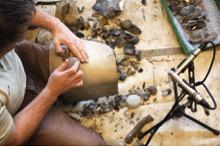Performing Machines
Using machines to produce artwork is an easy concept to grasp - since Andy Warhol’s Factory we are used to the idea of art as a commodity, and artist as facilitator, not necessary the single-handed producer. But what about when it is the machines that are the artwork, and no longer work to produce, but work as a performance. It is not the artist doing the physical work (or even their assistants) but the machine. In physics the concept of work can be interpreted as the measurement of the accomplishment of a task. To do work, effort (force) is required. However effort does not necessarily mean that work is done. The effort must accomplish something… a displacement must accompany the effort. But when a machine does not accomplish anything, as is the case in the examples I’m exploring, the act of working then becomes the work. There is no end commodity except work itself. With no end goal the ‘work’ is exposed.
Architect Helena Mattsson discusses this exposure of work in terms of the relationship between public space and work space. Work is turned into a commodity: “By introducing a public space into what is normally a closed structure, the organisation is opened up and the internal parts of its machinery are laid out for public inspection. This exhibitionistic display aestheticises everyday life, as well as work, by making it into entertainment”. In Manchester, our rich industrial heritage often seeps into our art. The once private cotton industry has become aesthetised by museums, and reinterpreted by artists. The cotton industry was famously dangerous and unethical; factories were tucked away, just outside cities, with the workers housed together, also hidden. By making machines perform, artists (like museums) are exposing the beauty of industry whilst also dismissing the pressure of production (a pressure felt by both factory workers and artists alike).
In this blog I have found examples of artworks that involve machines as artworks, working to no end other than to perform.










